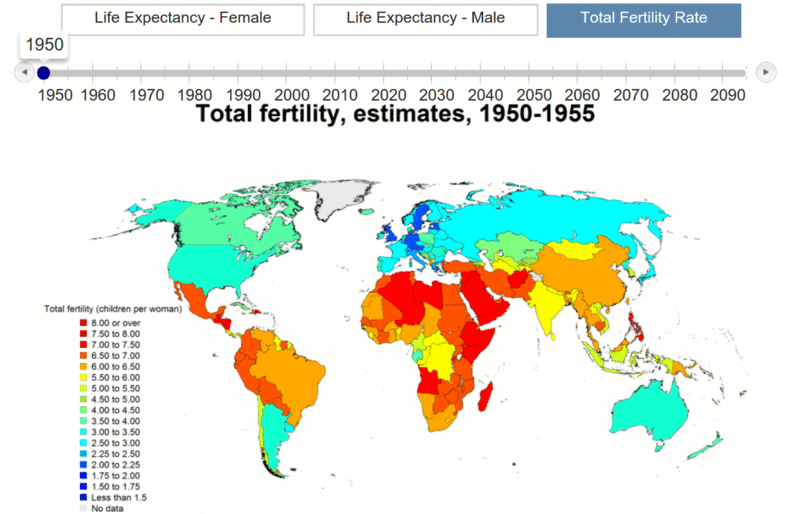Population replacement rate
Replacement rate is the number of children that a couple would have to have over the course of their reproductive years in order to replace themselves.[1] The UN states that this replacement rate worldwide is 2.1 children per couple;[2] however, some regions have higher or lower rates depending on whether or not the country is developed, with less developed countries needing 2.3 children born per couple to replace the population.[3] This additional 0.1 or 0.3 is due to the fact that replacement cannot occur if a child does not live to the end of their reproductive years and have their own children; thus, this extra is added per couple to account for death or infertility as adults.[3] Therefore, less stable countries require higher numbers of children to be born per couple on average since more people don't make it to the end of their reproductive years.
As countries develop, fertility rates generally tend towards the replacement rate.[2] This is due to decreased levels of child mortality, better access to food and medicine, and fewer cases of civil war. Being able to look at a country's total fertility rate in comparison to its replacement rate can give insight into whether or not the population of the country will increase or decrease, generally speaking. Countries that have a higher total fertility rate compared to their replacement rate—the population growth will be positive. In contrast, if the total fertility rate is lower than the replacement rate there will eventually be a negative population growth. However, it often takes decades for the population to actually experience a decrease.[4] Also, fertility rate is only one factor in determining the long-term population; emigration and immigration rates also play into a country's population growth. For example, Canada's population is growing because almost as many people are immigrating to Canada as are being born here.[5]
For Further Reading
References
- ↑ Population Reference Bureau. (2015, Mar. 5). Glossary of Demographic Terms [Online]. Available: http://www.prb.org/Publications/Lesson-Plans/Glossary.aspx
- ↑ 2.0 2.1 UN Population Division. (2015, Mar. 5). World Urbanization Prospects (2014 Revision) [Online]. Available: http://esa.un.org/unpd/wup/Country-Profiles/.
- ↑ 3.0 3.1 Matt Rosenburg. (2015, Mar. 5). Total Fertility Rate [Online]. Available: http://geography.about.com/od/populationgeography/a/fertilityrate.htm
- ↑ Statistics Canada. (2015, Mar. 5). Components of Population Growth [Online]. Available: http://www.statcan.gc.ca/pub/91-003-x/2007001/4129903-eng.htm
- ↑ See Stat's Canada data online (accessed March 16th, 2015): http://www.statcan.gc.ca/pub/91-209-x/2013001/article/11784/c-g/fig01-eng.htm and http://www.statcan.gc.ca/pub/91-209-x/2013001/article/11787/fig/fig1-eng.htm
- ↑ This image was taken from wikimedia's image repository, accessed July 17th, 2018. https://en.wikipedia.org/wiki/File:Total_Fertility_Rate,_1950_-_2100,_World_Population_Prospects_2015,_United_Nations.gif. The data comes from the United Nations, Department of Economic and Social Affairs, Population Division. For more information please see here.


